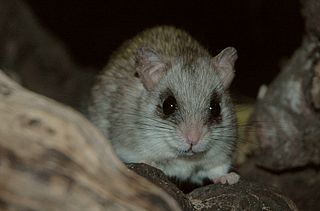
The lowland nyala or simply nyala, is a spiral-horned antelope native to southern Africa. It is a species of the family Bovidae and genus Tragelaphus, previously placed in genus Nyala. It was first described in 1849 by George French Angas. The body length is 135–195 cm (53–77 in), and it weighs 55–140 kg (121–309 lb). The coat is maroon or rufous brown in females and juveniles, but grows a dark brown or slate grey, often tinged with blue, in adult males. Females and young males have ten or more white stripes on their sides. Only males have horns, 60–83 cm (24–33 in) long and yellow-tipped. It exhibits the highest sexual dimorphism among the spiral-horned antelopes. It is not to be confused with the endangered mountain nyala living in the Bale region of Ethiopia).
The rusty pipistrelle is a species of vesper bat. It is found in Angola, Botswana, Burkina Faso, Central African Republic, Chad, Ethiopia, Ghana, Kenya, Malawi, Mozambique, Namibia, Nigeria, Senegal, South Africa, Sudan, Tanzania, Uganda, Zambia, and Zimbabwe. Its natural habitats are dry and moist savanna. It is of note as perhaps Africa's smallest bat, at average weight of 3.5 g (0.12 oz).
The southern African spiny mouse is a species of rodent in the family Muridae. It is found in Botswana, Democratic Republic of the Congo, Malawi, Mozambique, South Africa, Tanzania, Zambia, and Zimbabwe. Its natural habitats are moist savanna and rocky areas.

The Namaqua rock rat is a species of rodent in the family Muridae. It is sometimes included in the genus Micaelamys. It is found in Angola, Botswana, Lesotho, Malawi, Mozambique, Namibia, South Africa, Eswatini, Zambia, and Zimbabwe. Its natural habitats are temperate forest, dry savanna, temperate shrubland, subtropical or tropical dry shrubland, temperate grassland, rocky areas, hot desert, temperate desert, rocky shores, arable land, rural gardens, and urban areas.
The arid thicket rat is a species of rodent in the family Muridae. It is found only in Sudan. Its natural habitat is subtropical or tropical dry shrubland. This species is currently listed on the "Nearly Threatened" list in its ranking of endangerment. Offspring of this species are commonly referred to as "kittens" or "pups". The female is referred to as a "doe", while the male is referred to as a "buck". These creatures commonly roam in groups, called a "horde", "pack", or "storm".

Grammomys is a genus of rodent in the family Muridae endemic to Africa. It contains the following species:
Bunting's thicket rat is a species of rodent in the family Muridae. It is found in Ivory Coast, Guinea, Liberia, Senegal, and Sierra Leone. Its natural habitats are subtropical or tropical moist lowland forests and subtropical or tropical moist shrubland.
The gray-headed thicket rat is a species of rodent in the family Muridae. It is found in Kenya and Somalia. Its natural habitat is subtropical or tropical dry shrubland.

The woodland thicket rat is a species of rodent in the family Muridae. It is found in Angola, Burundi, Democratic Republic of the Congo, Kenya, Malawi, Mozambique, Rwanda, South Africa, South Sudan, Eswatini, Tanzania, Zambia, and Zimbabwe. Its natural habitats are subtropical or tropical dry forest, subtropical or tropical moist lowland forest, subtropical or tropical dry shrubland, subtropical or tropical moist shrubland, subtropical or tropical high-altitude shrubland, subtropical or tropical dry lowland grassland, arable land, pastureland, and urban areas.
The forest thicket rat is a species of rodent in the family Muridae. It is found in Burundi, Democratic Republic of the Congo, and Uganda. Its natural habitat is subtropical or tropical moist montane forests.
The Ruwenzori thicket rat is a species of rodent in the family Muridae. It is found in Kenya, Malawi, South Sudan, Tanzania, Uganda, and Zambia. Its natural habitats are subtropical or tropical moist montane forests and subtropical or tropical high-altitude shrubland. It is threatened by habitat loss.
Macmillan's thicket rat is a species of rodent in the family Muridae. It is found in Central African Republic, Democratic Republic of the Congo, Ethiopia, Kenya, South Sudan, Tanzania, and Uganda. Its natural habitats are subtropical or tropical moist lowland forest, subtropical or tropical swamps, subtropical or tropical seasonally wet or flooded lowland grassland, shrub-dominated wetlands, and urban areas.
The Ethiopian thicket rat is a species of rodent in the family Muridae. It is found only in Ethiopia. Its natural habitat is subtropical or tropical dry shrubland. It is threatened by habitat loss.
The shining thicket rat is a species of rodent in the family Muridae.

The single-striped grass mouse or single-striped lemniscomys is a species of rodent in the family Muridae.

The acacia rat is a species of rodent in the family Muridae. It is found in Botswana, Democratic Republic of the Congo, Ethiopia, Kenya, Malawi, Mozambique, Namibia, Somalia, South Africa, Eswatini, Tanzania, Zambia, and Zimbabwe. Its natural habitat is subtropical or tropical dry shrubland.

The Peters's epauletted fruit bat is a species of megabat in the family Pteropodidae. It is found in Angola, Botswana, Democratic Republic of the Congo, Eswatini, Malawi, Mozambique, Namibia, Tanzania, Zambia, and Zimbabwe. Its natural habitat is in riverine or evergreen forest, or moist woodland, where there are fruit-bearing trees.
The eastern rainforest grammomys, also known as the eastern rainforest thicket rat, is a species of rodent from the family Muridae.

Arvicanthini is a tribe of muroid rodents in the subfamily Murinae. Almost all recent species in this tribe are or were found in Africa aside from one species, the Indian bush rat, which is found in South Asia and Iran. However, some fossil Golunda species from India and the genus Parapelomys are thought to have also occurred outside Africa, and one species in the fossil genus Saidomys may have also occurred in Afghanistan.







